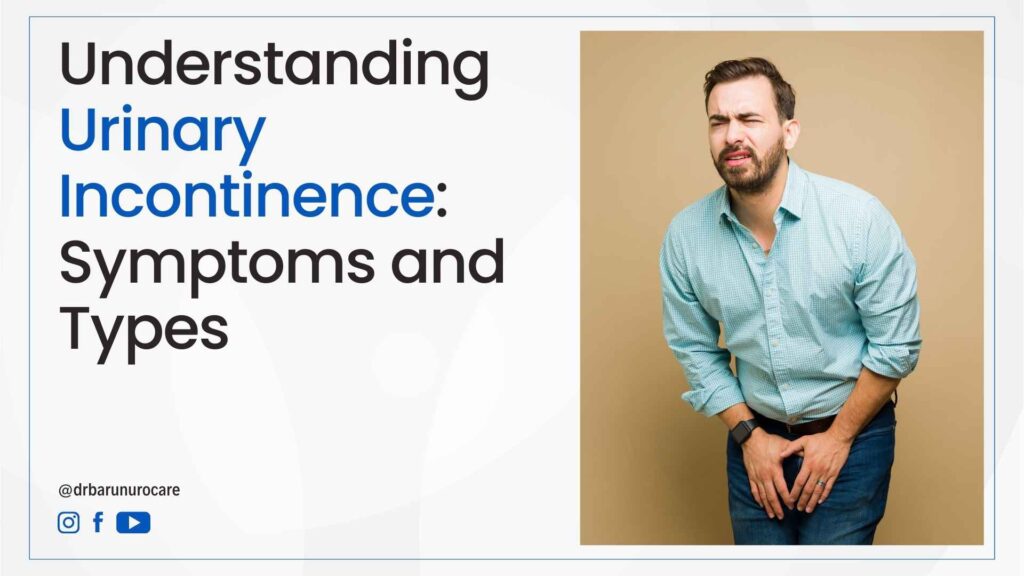Urinary incontinence, or the involuntary leakage of urine, is a more common condition than many people realize. In India, millions of individuals, both men and women, are affected by this condition. While it can be embarrassing and distressing, it’s important to remember that urinary incontinence is a treatable medical condition.
In this blog post, I’ll delve into the various types of urinary incontinence, their symptoms, and when it’s time to seek professional help. My goal is to provide you with a comprehensive understanding of this condition so you can take the necessary steps to manage it effectively.
Types of Urinary Incontinence
Urinary incontinence can manifest in several ways, each with its own unique causes and symptoms. Understanding the different types can help you identify your specific condition and explore appropriate treatment options.
- Stress Incontinence occurs when urine leaks during physical activity, such as coughing, sneezing, laughing, or lifting heavy objects. This is often caused by weakened pelvic floor muscles, which support the bladder and urethra.
- Urge Incontinence involves a sudden and strong urge to urinate, followed by involuntary leakage. This can be due to an overactive bladder or underlying neurological conditions.
- Mixed Incontinence is a combination of stress and urge incontinence. Some individuals may experience both types of leakage at different times.
- Overflow Incontinence happens when the bladder is unable to empty completely, leading to leakage. This can be caused by conditions such as an enlarged prostate or urinary tract obstruction.
- Functional Incontinence is a type of incontinence that occurs when a person is unable to reach the toilet in time due to physical or cognitive limitations. This might be caused by mobility issues, dementia, or other conditions.
- Nocturnal Enuresis refers to bedwetting in children and adults. It can be caused by various factors, including hormonal imbalances, sleep disorders, or underlying medical conditions.
Symptoms of Urinary Incontinence
Recognizing the signs and symptoms of urinary incontinence is essential for early diagnosis and treatment. Some common symptoms include:
- Frequent urination: Experiencing a need to urinate more often than usual.
- Sudden urge to urinate: Feeling a strong, unexpected urge to urinate that’s difficult to resist.
- Leakage while laughing, coughing, or sneezing: Losing control of your bladder during physical activity or exertion.
- Bedwetting: Experiencing involuntary urination during sleep.
- Difficulty emptying the bladder: Having trouble completely emptying your bladder.
- Loss of bladder control: Being unable to hold in urine, leading to frequent accidents.
If you’re experiencing any of these symptoms, it’s important to consult with a healthcare professional for a proper evaluation and diagnosis.
When to See a Urologist
It’s important to seek medical attention if you’re experiencing symptoms of urinary incontinence that significantly impact your quality of life. Here are some situations when you should consider consulting with a urologist:
- Persistent or worsening symptoms: If your urinary incontinence symptoms are ongoing or getting worse over time.
- Frequent accidents: If you’re experiencing frequent leaks or accidents that are interfering with your daily activities.
- Pain or discomfort: If you’re experiencing pain or discomfort related to urinary incontinence.
- Concerns about underlying conditions: If you have concerns about an underlying medical condition that might be contributing to your urinary incontinence.
A urologist can accurately diagnose your condition and recommend appropriate treatment options.
Treatment Options
There are several effective treatment options available for urinary incontinence. The best approach will depend on the underlying cause and severity of your condition. Here are some common treatment options:
- Lifestyle changes: Making changes to your lifestyle, such as bladder training, pelvic floor exercises, and dietary adjustments, can often help manage urinary incontinence.
- Medications: Certain medications can help relax the bladder muscles or treat underlying conditions that contribute to incontinence.
- Surgery: In some cases, surgical procedures may be necessary to correct underlying anatomical problems or to implant devices that can help control urinary leakage.
- Devices: Devices such as catheters or pads can be used to manage incontinence, especially in cases where other treatments are not effective.
It’s important to discuss your treatment options with your urologist to determine the most appropriate approach for your individual needs.
Conclusion
Urinary incontinence is a common condition that can be both embarrassing and distressing. However, it’s important to remember that it’s a treatable medical condition. By understanding the different types of urinary incontinence, recognizing the symptoms, and seeking appropriate medical advice, you can take control of your condition and improve your quality of life.
If you’re experiencing symptoms of urinary incontinence, don’t hesitate to schedule a consultation with me. I can provide a comprehensive evaluation, diagnose your condition, and recommend the most appropriate treatment plan. Together, we can work to improve your quality of life and regain your confidence.
Frequently Asked Questions About Urinary Incontinence
Q: Is urinary incontinence a common problem in India?
A: Yes, urinary incontinence is a common condition affecting people of all ages in India. While it can be embarrassing, it’s important to remember that it’s a treatable medical condition.
Q: What are the most common types of urinary incontinence?
A: The most common types of urinary incontinence include stress incontinence, urge incontinence, mixed incontinence, and overflow incontinence.
Q: How can I tell if I have urinary incontinence?
A: Symptoms of urinary incontinence can include frequent urination, sudden urge to urinate, leakage while laughing, coughing, or sneezing, bedwetting, difficulty emptying the bladder, and loss of bladder control.
Q: Is urinary incontinence a normal part of aging?
A: While urinary incontinence is more common in older adults, it’s not a normal part of aging. Many people can manage or even prevent urinary incontinence with appropriate treatment and lifestyle changes.
Q: Can urinary incontinence be treated?
A: Yes, urinary incontinence can be treated. The best approach will depend on the underlying cause and severity of your condition. Common treatment options include lifestyle changes, medications, surgery, and devices.
Q: When should I see a urologist?
A: If you’re experiencing symptoms of urinary incontinence that significantly impact your quality of life, it’s important to consult with a urologist. They can accurately diagnose your condition and recommend appropriate treatment options.
Q: Is it safe to talk to my doctor about urinary incontinence?
A: Absolutely. Your doctor is there to help you, and they’ve heard it all before. It’s important to be open and honest with your doctor about your symptoms so they can provide you with the best possible care.



